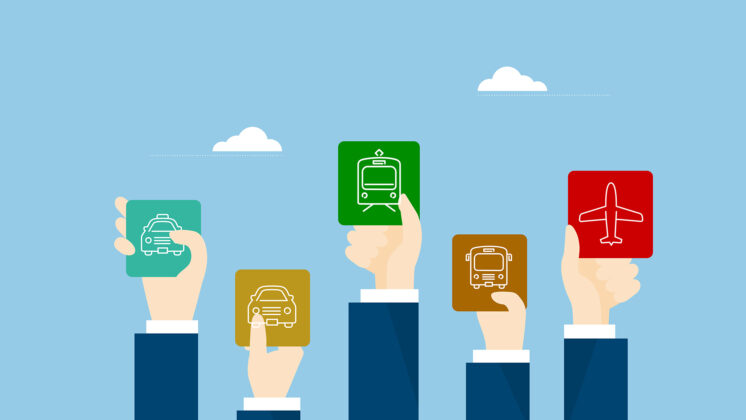From super-fast Shinkansen “bullet trains” to local rail connections in and around Tokyo, trains operated by the East Japan Railway Company (JR East) are a critical part of daily life in Japan. Just one of the company’s roughly seventy lines—the Yamanote Line encircling central Tokyo—carries more than a billion passengers a year.
But now JR East is expanding its focus, venturing into the digital realm with tools like mobility as a service (MaaS), digital payment platforms, and sophisticated data marketing. Digital transformation, or DX, is a focus of many companies. Some try to handle DX internally, while others look for help from consulting firms and rising startups.
How does a railway embrace DX?
We interviewed Yukiko Ono, the executive who’s helping to drive DX changes as deputy general manager of JR East’s MaaS & Suica Headquarters.

Next Article
Catalyzing Digital Transformation through the Human Element
The True-False Digital Transformation Quiz: Test Your Tech Knowledge!
Leveraging Data to Meet Customer Needs
Insights: You oversee JR East’s data marketing and MaaS initiatives, including the popular Suica touchless payment system. What exactly does your job entail?
Ono: I work to help different business units provide better services to customers and leverage data marketing across the whole JR East business, including group companies. Data marketing (and DX in general) can’t be done by a single department alone, so we work across the organization by making proposals and building the foundations for digital transformation.
Insights: JR East is a huge company. Cross-coordination like that must be difficult.
Ono: It is! Every department works with a strong sense of responsibility, but they often don’t pay attention to what other departments are doing. It’s our job to breach these silos and bring everyone together.
DX is a matter of balance and coordination. The railroad business is our mainstay, and the data involved is often sensitive. It needs to be protected. Sometimes, for one reason or another, a department doesn’t think using a certain kind of data is a good idea. In such cases, we need to look for win-win DX approaches that satisfy everyone.
Insights: Your new MaaS service, RingoPass, extends to things like taxis and shared bicycles. Is the way you view your customers changing? It seems you’re now trying to offer transport options even after someone gets off a train.
Ono: Until now, we have always thought of our customers as people who ride trains and pass through train stations. But now, facing DX, we’re thinking more broadly—about people’s happiness. Customer needs don’t end at the station steps. Each of their actions is connected. Data helps us anticipate those connections and provide better services. Secondary transport such as taxis and shared bicycles are part of getting from departure point to destination. So we thought we should provide the “flow” to get customers through their whole journey smoothly.
This idea is supported by top management. In July 2018, we announced a new strategy called “Move UP 2027.” It includes a commitment by our president and CEO to completely change the way we think. We want to embed innovation into the workplace. Changing the way we perceive our customers is part of that.
Insights: It sounds like that business approach goes beyond railroads to involve station buildings, retail facilities, and customers’ lives in general.
Ono: MaaS stands for “mobility as a service.” But you could also think of it as a way to make daily life smoother through integration.
A “Teachable Attitude” to Working with Startups
Insights: You’ve been collaborating with startups to develop new digital tools like your smartphone app. How do you make this kind of collaboration work, given the differences in culture between startups and big, established companies like JR East?
Ono: When we decided to revamp the JR East app, we approached IDEO to learn about design thinking. Then IDEO introduced us to another company called Pivotal Japan (now VMware). We learned about agile development while working with them. There were so many things I didn’t understand at the beginning. It was probably a good thing that I went in with a learning mindset.
Design thinking, agile development, lean startups . . . These are all based on the idea of clarifying roles and discussing things on an equal footing, determining what the customer wants and then quickly developing the product. It’s a good way of working because it flattens relationships among stakeholders.
It was also important that our company’s leaders had a solid understanding of the project. We’re very cautious when it comes to things like operational safety. But since the smartphone app is something quite different, we were able to take a more experimental, try-and-see approach.
Insights: So your digital tools are developed in collaboration with other companies, not simply outsourced?
Ono: That’s right. The East Japan App, RingoPass, and another tool we call Sightseeing MaaS are being developed with partner companies, but the project managers are JR East employees. Of course, we procure large data-management systems from specialist companies, but development of both the app and the underlying business were done in-house. We’ve built a system for in-house production to ensure that our ideas are always reflected in the product.
COVID-19 and Accelerated Digitalization
Insights: A lot of companies are pursuing digital transformation—DX, in the jargon. What do you think is the fundamental value of DX?
Ono: “Doing DX” isn’t our objective. Our objective is to improve the business. To do that, we need to fundamentally change the way we operate, and I think that is what DX is all about.
The COVID-19 pandemic has made me keenly aware that Japanese companies rely a lot on tacit knowledge. That is, they use a lot of procedures and so on that aren’t codified, but are simply understood by members of close-knit groups. That worked well in the past, but with the spread of remote work, it’s become clear that we need to shift to a more formalized kind of knowledge. That’s also a prerequisite for DX.
So as disastrous as the pandemic has been, one upside is that it has helped accelerate digitalization.
In the case of JR East, COVID-19 pushed forward our plans for “Move UP 2027.” Looking ahead to the post-corona period, I think we’ve gained momentum and a new capacity to consider projects from the perspective of our customers and local communities.
Insights: What new digital initiatives can we expect from JR East?
Ono: We have a variety of missions, but when the MaaS & Suica Headquarters was set up, the guiding vision was to make travel seamless. We wanted to create a one-stop shop for various services and introduce new services that make use of digital data. Through trial and error, we’re making life smoother and easier for everybody, from small children to the elderly and the disabled. And from a business perspective, we want to bring big and small companies, startups, and the public sector together, too.





